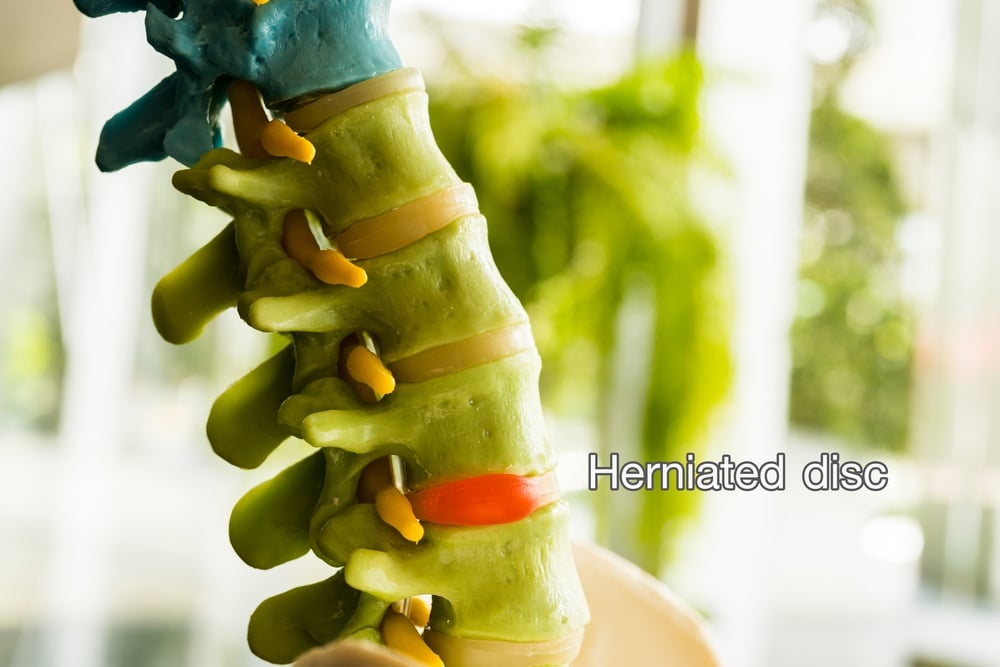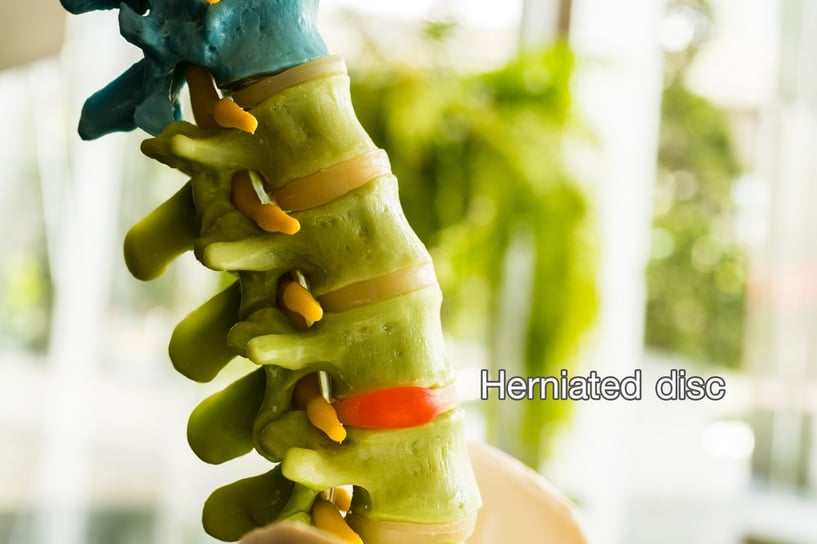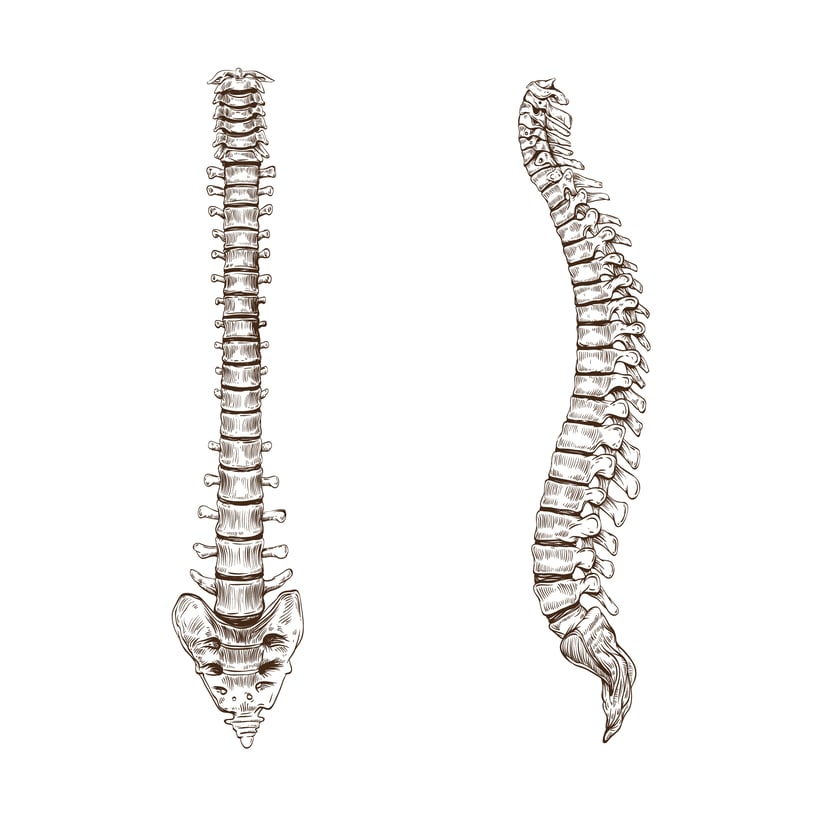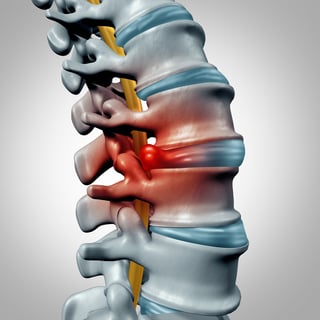Common Causes and Risk Factors of a Herniated Disc
May 30th, 2017 | 3 min. read


Minor neck and back pain is a relatively common ailment. Most such pains may be considered to be minor nuisances, and are likely to have been caused by impact injuries (contusions), pulled muscles (strains) and overstretched ligaments (sprains). These pains are easily treatable with over-the-counter (OTC) medications, ice packs, heat packs, and rest. One to two weeks of conservative treatments often do the trick for relieving this minor spinal pain.
Unfortunately, millions of people suffering from neck and back pain are dealing with a more serious, chronic (long-term) condition: a herniated disc. Some studies find as many as half of all Americans over the age of 50—and one-third of all Americans total—suffer from some form of disc herniation.
What Is a Disc?
 The human spine is a stacked column of 23 discs and 33 bones (vertebrae). The vertebrae provide structural strength, stability, and protection, while the discs provide the following:
The human spine is a stacked column of 23 discs and 33 bones (vertebrae). The vertebrae provide structural strength, stability, and protection, while the discs provide the following:
- proper spacing between each vertebrae
- dynamic alignment of the entire spinal column
- flexibility throughout the torso
- excellent shock absorption against impacts, as well as from the everyday stresses of walking, jumping, running, etc.
The spine’s 23 discs alternate with the first 23 vertebrae. The lower eight vertebrae are fused into two structures, the sacrum and the coccyx, and contain no intervertebral discs.
The outsides of the discs (called the annulus fibrosis) are made of thick, pliable, rubbery cartilage. This is the same type of connective tissue that makes up your nose and outer ears, as well as the internal tissues that wrap and protect your joints.
Inside of each disc is a jelly-like substance, called the nucleus pulposus. It is this thick, liquidy fluid that allows the disc to absorb vertical shocks so well.
What Is a Herniated Disc?
In medicine, the word “herniation” is defined as: “the abnormal protrusion of a body organ or other tissue through an  opening in its surrounding membrane, muscle, or bone.”
opening in its surrounding membrane, muscle, or bone.”
A herniated disc is exactly that: the outer layer of the disc (annulus fibrosis) becomes damaged or torn badly enough for the inner liquid (nucleus pulposus) to leak, or herniate, out of its normally sealed compartment.
Pain may occur inside the damaged disc itself (axial pain), outside of the disc (radicular pain), or at both locations. Inside the disc, the oozing liquid may irritate the nerves located within the disc itself, due to the inflammatory proteins that comprise the nucleus pulposus.
Should the nucleus pulposus gel herniate outside of the disc entirely, it may cause pressure and irritation on the spinal nerves running past it. This condition is sometimes called a compressed nerve, or a pinched nerve.
Are There Other Names for this Condition?
There are many terms that refer to a herniated disk. Among the many very descriptive synonyms are:
- Slipped disc
- Ruptured disc
- Torn disc
- Collapsed disc
- Bulging disc
- Disc protrusion
- Disc disease
- Black disc
A slipped disc may also be classified by its location. The bones of the spine are grouped into three primary areas (remember, the final 8 vertebrae are fused and contain no discs) that identify where the disc disease has occurred.
- Cervical: located in the neck (cervical spine), between vertebrae 1-7. This is a common location for slipped discs.
- Thoracic: occurred in the chest or middle back (thoracic spine), between vertebrae 8-20. This area has a relatively uncommon occurrence for disc damage.
- Lumbar: centered in the lower back (lumbar spine), between vertebrae 21-25. This is the most common area in which to suffer a herniated disc.
Most Common Herniated Disc Causes
The lower back is the most common location for a herniated disc to occur. This area of the spine serves as the base of support for the entire upper body, and most twisting and lifting motions occur in the lumbar region.
The cervical spine, or neck, is another common area for slipped discs. The human head weighs approximately eleven pounds, which is supported entirely by the first vertebra at the top of the spinal column.
The two most common causes of disc injury are aging and injury.
- Aging. All discs experience a normal amount of degeneration throughout a lifetime of use. The inner gel of a disc will lose a certain amount of water as it ages, making it less flexible and reducing the effectiveness of its cushioning abilities. The cartilage comprising the outer layer of a disc is also subject to regular “wear and tear.” It may become frayed or thin with time, making it more vulnerable to stresses that could result in rips and tears.
- Injury. Any physical exertion that puts excess strain on your back may cause a disc rupture. For example:
- Lifting an object too heavy for your back to handle without damage.
- Improperly lifting an object. The old adage “lift with your legs, not with your back” was created to prevent slipped discs.
- Quick or violent twisting motions, such as experiencing a hard sideways tackle in football, or falling and twisting simultaneously
- Forcing your neck or upper body to turn or twist beyond its capability; for example, performing trunk twist exercises with heavy weights that pull your body farther than the back can safely handle.
What Are the Risk Factors Increasing the Chances of a Slipped Disc?
Doctors have identified some factors that will increase the risk of suffering a herniated intervertebral disc. They include the following:
- Carrying excess body weight. People carrying too much body weight will cause excessive stress on the discs of the lower back. Obesity is defined as having a BMI (Body Mass Index) of 30 or higher. (BMI = weight divided by height squared)
- Having weak muscles in the back, abdomen, and legs
- Working in a physically demanding occupation, particularly if you are unable to take sufficient rest and recuperative time
- Performing repetitive motions. Lifting, pushing, pulling, bending sideways, and twisting all place unusual stresses on your back. Doing these types of motions repeatedly will increase the chances of a disc rupture.
- Genetic predisposition
In addition, men are statistically more likely to experience some form of disc disease than women.
Feel free to call Coastal Orthopedics in Corpus Christi todat to schedual an appointment at (361) 994-1166.
Article written by: Rob Williams, MD
Dr. Williams has been practicing orthopedic surgery in Corpus Christi since 1998. After graduating from Texas Tech hereceived his medical degree from the University of Texas at San Antonio. At the prestigious Campbell Clinic located at the University of Tennessee, Dr. Williams completed not only an Orthopedic Surgery Residency, but an additional year of Fellowship Training in Spine Surgery. Dr. Williams is dedicated to creating an excellent patient experience in the office or in the surgery suite.
Topics:

